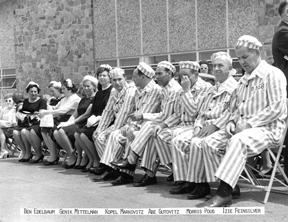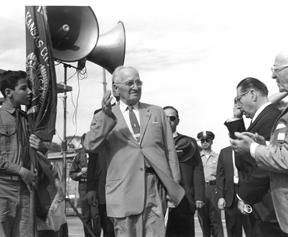
The Midwest Center for Holocaust Education (MCHE) will present a “Pop Up at the Monument” event about the Memorial to the Six Million from 1 p.m. to 1:30 p.m. Tuesday, May 8, at the Jewish Community Campus.
This event, and a pop up held in April, takes place as the community commemorates the 55th anniversary of the dedication of the memorial. May 8 is also significant as it is V-E Day, which commemorates the date in 1945 when the Allies celebrated the defeat of Nazi Germany, formally recognizing the end of World War II in Europe.
Shelly Cline, Ph.D., MCHE’s public historian, will give a presentation about the monument, which is on the east side of the main parking lot at the Campus.
The monument was created by Maurice Newman, a Washington, D.C., artist and a native of Lithuania. It was dedicated on June 9, 1963, at the Jewish Community Center when it was located at 80th Street and Holmes Road in Kansas City, Missouri. Then-former President Harry S. Truman gave the ceremony’s keynote address. A video of the ceremony is on the MCHE’s website (https://mchekc.org/monument/).
The monument was moved in 1984 to the Jewish Community Center’s temporary location at Indian Creek and again in 1988 to its current location.
The Memorial to the Six Million also includes the Warsaw Ghetto Monument. Both were organized, funded and sponsored entirely by members of The New Americans Club of the Jewish Community Center of Kansas City. It was formed in 1958 by a small group of Holocaust survivors, most of whom had immigrated to Kansas City shortly after World War II.

The monument is made of aluminum and sits on a marble base. It cost $15,000 to build, which is equivalent to $120,000 today, Cline said. It was one of the first monuments in the United States dedicated to remembrance of the Holocaust.
“Several waves of Holocaust memorials happened,” she said. “Right after liberation, sometimes an immediate marker was put up at the concentration camp sites and sometimes a year later. It was not a formal effort. A lot of these initial attempts immediately after the war looked like conventional war memorials with an obelisk (or other symbols) but not specifically representative of the Holocaust.”
Skeletal figures on the front of the monument reach around from the Holocaust to dual depictions of the biblical Exodus and the exodus of European Jews to Israel or America, both countries symbolizing “a better, hopeful, freer world,” she said.
The monument is cleaned annually with a very mild acid similar to a detergent to remove tree sap, pollution from vehicle exhaust and tire particles, and any other accumulated dirt, said Timothy Kelly, owner and president of Commercial Waterproofing Inc. in Parkville, Missouri.
The company’s workers use a fine sprayer to apply the cleaning solution to the monument, scrub it with nylon brushes and then pressure wash it. They first tape off the monument’s marble base and wet it with water to protect it from the cleaning solution, which could etch the marble if it isn’t protected.
“It’s a little bit of love and elbow grease,” Kelly said.
The monument has a lot of realistic detail, especially on its back side, which depicts the ghetto and its streets, and a group of people leaving it and heading into a fiery door, which symbolizes the killing centers.
“When you look at the back of it, the eye is first drawn to the empty ghetto because the people have been taken,” she said. “Where have they been taken? To be killed. … The only thing that is grim on the front is the skeletal figures reaching out to be remembered. It’s (otherwise) a hopeful exodus scene.”
Cline said she had frequently driven by the monument for years without knowing what it was.
“It’s easy to miss from afar,” she said. “When you’re up close, you’re struck by how much detail it has. What has drawn me to it is the closer you look, the more there is. For me, that’s what makes it a powerful piece, that there’s so much going on.”
About the Memorial to the Six Million
In 1958, a small group of Holocaust survivors, most of whom had immigrated to Kansas City shortly after World War II, met with Sol E. Margolin, executive director of the Jewish Community Center, to consider ways to commemorate the Holocaust. This meeting led to the formation of what they would call “The New Americans Club of the Jewish Community Center of Kansas City.”
The following year, in 1959, two especially significant projects emerged from that meeting: the annual Yom HaShoah service, which the New Americans called the Warsaw Ghetto Memorial Service and the Warsaw Ghetto Monument (the sculpture that stood at the entrance to the old Jewish Community Center on Holmes Road and that now stands on the northeast corner of this Jewish Community Campus in Overland Park, Kansas). The New Americans named this the Memorial to the Six Million.
Both projects were among the first of their kind in the United States. Both were organized, funded and sponsored entirely by members of The New Americans Club and would be among their most enduring legacies to our community.
The memorial, created by Maurice Newman, was dedicated on June 9, 1963, at a ceremony featuring a keynote address by former President Harry S Truman.
“The tremendous effort and perseverance you have displayed to realize The Memorial to Six Million Martyrs finds full justification in the result — a stirring warning that we are never done with war against prejudice and persecution. Let us resolve to work together toward making this ‘humanity’s century,’ a century of lasting peace and universal justice,” Truman said.
Reprinted with permission of the Midwest Center for Holocaust Education, mchekc.org.



